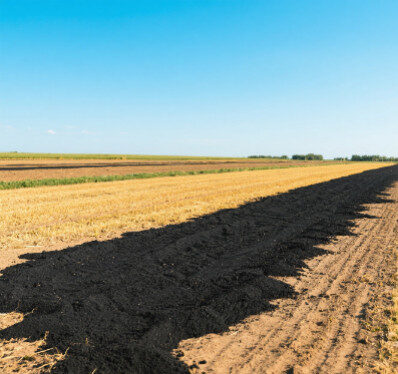Potassium fulvate is a versatile soil conditioner and plant growth stimulant that plays a pivotal role in modern agriculture. However, not all potassium fulvate products are created equal. The two primary variants, mineral-derived potassium fulvate (M-KF) and biochemical potassium fulvate (B-KF), offer distinct advantages and limitations. This necessitates careful consideration by agronomists, farmers, and agricultural input suppliers. This article delves into their differences, applications, and selection criteria to empower informed decision-making.
1. Origin and Production: Unveiling the Roots
- Mineral-Derived Potassium Fulvate (M-KF):
It is extracted from natural deposits such as leonardite, a type of weathered brown coal rich in humic substances, as well as lignite, a soft form of coal also known as brown coal. M-KF originates from ancient organic matter that formed over millions of years. It has a high concentration of fulvic acid (≥70% organic matter) and is enriched with naturally chelated trace elements (Zn, B, Fe, etc.). Potassium oxide (K₂O) is then added to create a stable, non-hygroscopic product. Its natural origin ensures consistency and long-term efficacy.
- Biochemical Potassium Fulvate (B-KF):
B-KF is synthesized from industrial byproducts such as waste from the production of sugar alcohol or monosodium glutamate. It contains polysaccharides and lignin, but has lower fulvic acid content (30-50% organic matter). It is highly hygroscopic and prone to clumping, requiring careful storage. Although it is cost-effective, its origins and composition differ significantly from M-KF.
2. Key Differences: A Performance Breakdown
| Parameter | Mineral-Derived (M-KF) | Biochemical (B-KF) |
| Origin | Leonardite/weathered coal | Industrial byproducts |
| Hygroscopicity | Non-hygroscopic | Highly hygroscopic |
| Application | Foliar, drip, soil | Soil drench only |
| Cost | Higher | Lower |
| Response Time | Rapid (2-3 days) | Slower, long-term soil improvement |
3. Agricultural Benefits and Mechanisms
- M-KF: Precision and efficiency
- Enhanced Nutrient Uptake: Chelated trace elements improve plant absorption, boosting metabolism. For instance, a 2020 study found that using M-KF increased wheat’s nutrient uptake by 15%.
- Stress Mitigation: Rapid action in drought or cold stress scenarios strengthens plant resilience. In regions experiencing drought, M-KF has been shown to improve plant survival rates by up to 30%.
- Soil Structure Improvement: Binds soil particles for better aeration and water retention. A field trial in India demonstrated that M-KF improved soil structure, leading to a 20% increase in water retention capacity.
- Fruit Quality Enhancement: Increases sugar accumulation, color, and shelf life in high-value crops. Growers in California reported a 10% increase in sugar content and a 15% extension in strawberry shelf life after using M-KF.
- B-KF: Cost-Effectiveness and Long-Term Impact
- Soil Carbon Enrichment: Adds organic matter to optimize C:N ratios for microbial activity.
- Microbial Stimulation: Supports beneficial soil microorganisms for sustainable fertility.
- Bulk Application: Ideal for large-scale field crops (e.g., wheat and corn) due to lower costs.
4. Strategic Application Guidelines:
- M-KF Best Practices:
- Foliar Spray (0.1%-0.3%): For immediate stress relief (e.g., heat waves, frost).
- Drip irrigation (1-3 kg/acre): Enhances root development and nutrient efficiency.
- Seed treatment accelerates germination and seedling vigor.
- Caution: Avoid overuse. Small doses suffice due to high activity.
- B-KF Best Practices:
- Soil Drench (5-10 kg/acre): Focus on improving the soil’s organic matter content.
- Avoid foliar or drip application. Polysaccharides may clog equipment.
- Storage: Seal in dry conditions to prevent clumping.
5. Choosing the Right Solution: A Scenario-Based Approach
| Scenario | Recommended Product | Reasoning |
| Immediate Stress Relief | M-KF | Rapid action, foliar compatibility |
| Long-Term Soil Health | B-KF | Cost-effective organic matter accumulation |
| High-Value Crops | M-KF | Superior fruit quality and yield |
| Large-Scale Field Crops | B-KF | Budget-friendly, bulk application feasibility |
Conclusion: Synergy for Success
While both M-KF and B-KF contribute to agricultural productivity, they have different strengths that align with specific goals. M-KF excels in precision nutrient delivery, stress management, and high-value crop cultivation. B-KF offers cost-effective soil conditioning for long-term fertility and large-scale farming. Strategically selecting one or the other, or potentially combining them with humic acid or seaweed extracts for synergistic effects, optimizes resource allocation and crop outcomes.
Looking ahead, researching novel application methods and formulations could further enhance these products’ efficacy. Additionally, integrating advanced technologies, such as precision agriculture and data analytics, could provide more tailored recommendations and unlock new possibilities for improving agricultural sustainability and productivity.









